On this tutorial, I’ll current the easiest way to assemble a really functioning CRUD app utilizing Node for the backend and htmx for the frontend. It’ll current how htmx integrates correct proper right into a full-stack software program program, permitting you to guage its effectiveness and determine if it’s a wide array to your future initiatives.
htmx is a updated JavaScript library designed to strengthen internet options by enabling partial HTML updates with out the necessity for full web internet web page reloads. It does this by sending HTML over the wire, versus the JSON payload related to conventional frontend frameworks.
Key Takeaways
- Make the most of Node.js and htmx to assemble a CRUD app, enhancing consumer expertise with SPA-like interactivity with out full web internet web page reloads.
- Guarantee accessibility and Website positioning-friendliness by making the app useful even when JavaScript is disabled, utilizing full-page refreshes.
- Manage the enterprise with Categorical as the net framework and Pug for templating, utilizing method-override to deal with HTTP verbs like PUT and DELETE.
- Implement dynamic content material materials supplies loading with htmx by making AJAX requests that return HTML, not JSON, enhancing the responsiveness of the app.
- Handle fully completely totally different consumer eventualities, very similar to direct URL entry or web internet web page refreshes, by checking for an HX-Request header and responding appropriately.
- Prolong the app’s effectivity by integrating database operations, dealing with sort submissions dynamically with htmx, and offering choices by flash messages.
What We’ll Be Establishing
We’ll develop a simple contact supervisor able to all CRUD actions: creating, studying, updating, and deleting contacts. By leveraging htmx, the making use of will current a single-page software program program (SPA) truly actually really feel, enhancing interactivity and consumer expertise.
If shoppers have JavaScript disabled, the app will work with full-page refreshes, sustaining usability and discoverability. This system showcases htmx’s means to create modern internet apps whereas holding them accessible and Website positioning-friendly.
Correct proper right here’s what we’ll find yourself with.
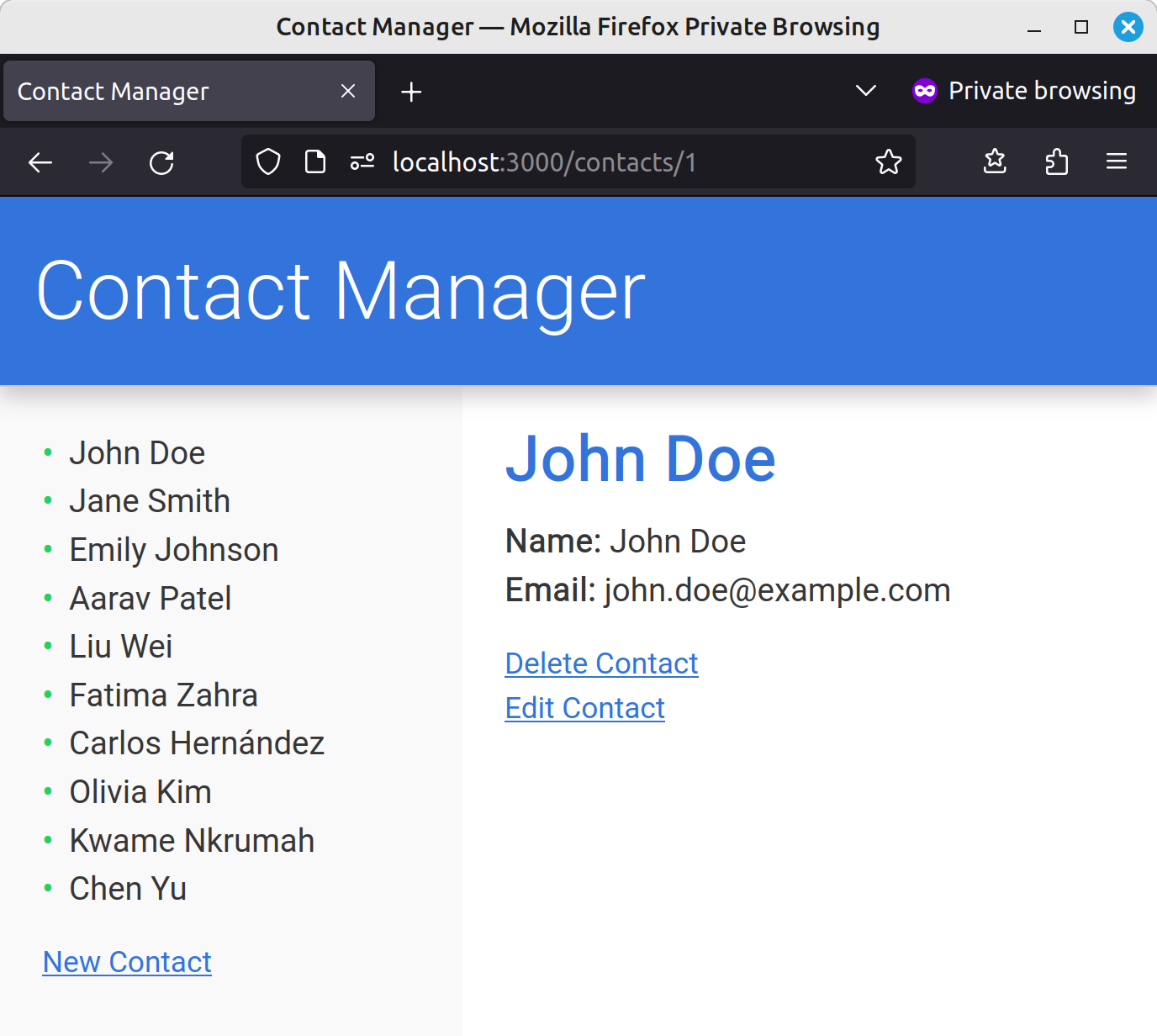
The code for this textual content material could be discovered on the accompanying GitHub repo.
Conditions
To observe together with this tutorial, you’ll want Node.js put in in your PC. Inside the event you don’t have Node put in, please head to the official Node purchase web internet web page and seize the correct binaries to your system. Alternatively, it is doable you will want to put in Node utilizing a model supervisor. This system helps you to prepare a wide range of Node variations and swap between them at will.
Aside from that, some familiarity with Node, Pug (which we’ll be utilizing on account of the template engine) and htmx could be useful, nonetheless not important. Inside the event you’d like a refresher on any of the above, try our tutorials: Assemble a Simple Newbie App with Node, A Data to the Pug HTML Template Preprocessor and An Introduction to htmx.
Before we start, run the following instructions:
node -v
npm -v
It’s best to see output like this:
v20.11.1
10.4.0
This confirms that Node and npm are put in in your machine and are accessible out of your command line atmosphere.
Setting Up the Mission
Let’s begin by scaffolding a mannequin new Node enterprise:
mkdir contact-manager
cd contact-manager
npm init -y
This would possibly create a package deal deal deal.json file contained in the enterprise root.
Subsequent, let’s prepare the dependencies we’re going to need:
npm i categorical method-override pug
Of those packages, Categorical is the spine of our app. It’s a quick and minimalist internet framework which presents a simple selection to deal with requests and responses, and to route URLs to express handler choices. Pug will carry out our template engine, whereas we’ll use method-override to make the most of HTTP verbs like PUT and DELETE in locations the place the patron doesn’t help them.
Subsequent, create an app.js file inside the basis itemizing:
contact app.js
And add the following content material materials supplies:
const categorical = require('categorical');
const path = require('path');
const routes = require('./routes/index');
const app = categorical();
app.set('views', path.be a part of(__dirname, 'views'));
app.set('view engine', 'pug');
app.use(categorical.static('public'));
app.use("https://www.sitepoint.com/", routes);
const server = app.pay attention(3000, () => {
console.log(`Categorical is engaged on port ${server.take care of().port}`);
});
Correct proper right here, we’re establishing the event of our Categorical app. This consists of configuring Pug as our view engine for rendering views, defining the itemizing for our static property, and hooking up our router.
The tools listens on port 3000, with a console log to substantiate that Categorical is working and able to deal with requests on the required port. This setup varieties the underside of our software program program and is able to be prolonged with additional effectivity and routes.
Subsequent, let’s create our routes file:
mkdir routes
contact routes/index.js
Open that file and add the following:
const categorical = require('categorical');
const router = categorical.Router();
router.get('/contacts', async (req, res) => {
res.ship('It truly works!');
});
module.exports = router;
Correct proper right here, we’re establishing a elementary route inside our newly created routes itemizing. This route listens for GET requests on the /contacts endpoint and responds with a simple affirmation message, indicating that every half is functioning appropriately.
Subsequent, substitute the “scripts” part of the package deal deal deal.json file with the following:
"scripts": {
"dev": "node --watch app.js"
},
This makes use of the mannequin new watch mode in Node.js, which is able to restart our app at any time when any modifications are detected.
Lastly, boot every half up with npm run dev and head to http://localhost:3000/contacts/ in your browser. It’s best to see a message saying “It truly works!”.
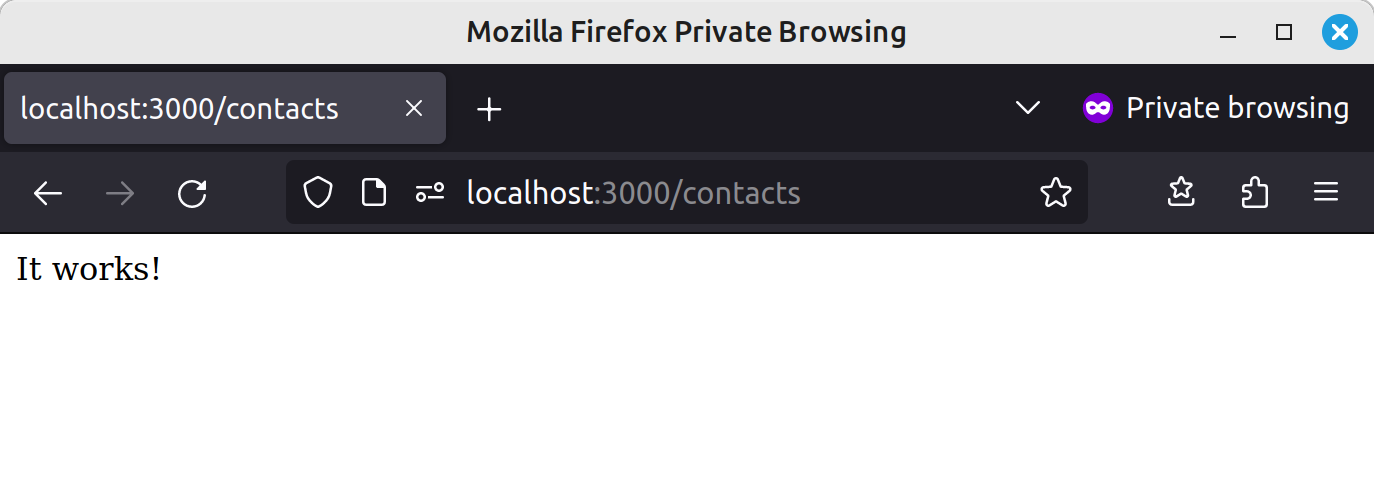
Thrilling instances!
Now let’s add some contacts to level out. As we’re specializing in htmx, we’ll use a hard-coded array for simplicity. It’ll preserve factors streamlined, permitting us to supply consideration to htmx’s dynamic selections with out the complexity of database integration.
For these obsessed with along with a database shortly, SQLite and Sequelize are good selections, providing a file-based system that doesn’t require a separate database server.
With that talked about, please add the following to index.js prior to the primary route:
const contacts = [
{ id: 1, name: 'John Doe', email: 'john.doe@example.com' },
{ id: 2, name: 'Jane Smith', email: 'jane.smith@example.com' },
{ id: 3, name: 'Emily Johnson', email: 'emily.johnson@example.com' },
{ id: 4, name: 'Aarav Patel', email: 'aarav.patel@example.com' },
{ id: 5, name: 'Liu Wei', email: 'liu.wei@example.com' },
{ id: 6, name: 'Fatima Zahra', email: 'fatima.zahra@example.com' },
{ id: 7, name: 'Carlos Hernández', email: 'carlos.hernandez@example.com' },
{ id: 8, name: 'Olivia Kim', email: 'olivia.kim@example.com' },
{ id: 9, name: 'Kwame Nkrumah', email: 'kwame.nkrumah@example.com' },
{ id: 10, name: 'Chen Yu', email: 'chen.yu@example.com' },
];
Now we have got to create a template for our path to level out. Create a views folder containing an index.pug file:
mkdir views
contact views/index.pug
And add the following:
doctype html
html
head
meta(charset='UTF-8')
title Contact Supervisor
hyperlink(rel='preconnect', href='https://fonts.googleapis.com')
hyperlink(rel='preconnect', href='https://fonts.gstatic.com', crossorigin)
hyperlink(href='https://fonts.googleapis.com/css2?household=Roboto:wght@300;400¤t=swap', rel='stylesheet')
hyperlink(rel='stylesheet', href='/varieties.css')
physique
header
a(href='/contacts')
h1 Contact Supervisor
half#sidebar
ul.contact-list
every contact in contacts
li #{contact.title}
div.actions
a(href='/contacts/new') New Contact
vital#content material materials supplies
p Choose a contact
script(src='https://unpkg.com/htmx.org@1.9.10')
On this template, we’re laying out the HTML constructing for our software program program. All through the pinnacle half, we’re together with the Roboto font from Google Fonts and a stylesheet for customized varieties.
The physique is break up correct proper right into a header, a sidebar for itemizing contacts, and a vital content material materials supplies space the place all of our contact information will go. The content material materials supplies space at present accommodates a placeholder. On the top of the physique we’re furthermore together with the newest model of the htmx library from a CDN.
The template expects to amass an array of contacts (in a contacts variable), which we iterate over contained in the sidebar and output every contact title in an unordered itemizing utilizing Pug’s interpolation syntax.
Subsequent, let’s create the customized stylesheet:
mkdir public
contact public/varieties.css
I don’t intend to itemizing the sorts correct proper right here. Please copy them from the CSS file contained in the accompanying GitHub repo, or be glad so as in order so as to add a few of your specific individual. 🙂
As soon as extra in index.js, let’s substitute our path to make the most of the template:
router.get('/contacts', (req, res) => {
res.render('index', { contacts });
});
Now for many who refresh the net internet web page you may see one issue like this.
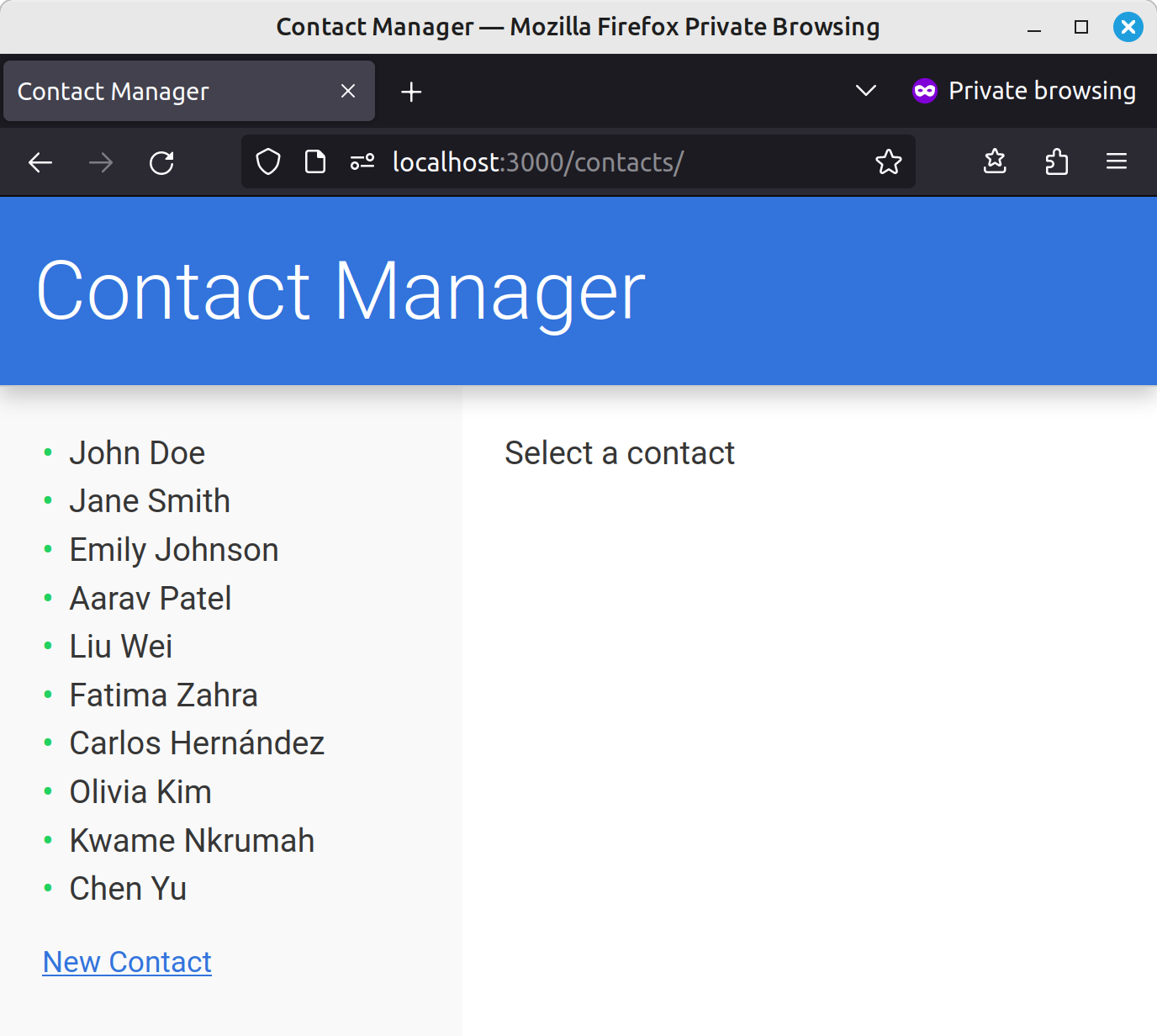
Up to now, all we’ve achieved is ready up a elementary Categorical app. Let’s change that and at last add htmx to the combo. The following step is to make it in order that when a consumer clicks on a contact contained in the sidebar, that contact’s information is displayed inside the principle content material materials supplies space — naturally and by no means using a full web internet web page reload.
To begin out out with, let’s swap the sidebar into its personal template:
contact views/sidebar.pug
Add the following to this new file:
ul.contact-list
every contact in contacts
li
a(
href=`/contacts/${contact.id}`,
hx-get=`/contacts/${contact.id}`,
hx-target='#content material materials supplies',
hx-push-url='true'
)= contact.title
div.actions
a(href='/contacts/new') New Contact
Correct proper right here we now have made every contact a hyperlink pointing to /contacts/${contact.id} and added three htmx attributes:
hx-get. When the patron clicks a hyperlink, htmx will intercept the press and make a GET request through Ajax to the/contacts/${contact.id}endpoint.hx-target. When the request completes, the response could also be inserted into the div with an ID ofcontent material materials supplies. We haven’t specified any sort of swap method correct proper right here, so the contents of the div could also be modified with no matter is returned from the Ajax request. That is the default conduct.hx-push-url. It’ll be certain that the worth specified byhtx-getis pushed onto the browser’s historic earlier stack, altering the URL.
Change index.pug to make the most of our template:
half#sidebar
embrace sidebar.pug
Take note of: Pug is white house delicate, so make sure you make use of the correct indentation.
Now let’s create a mannequin new endpoint in index.js to return the HTML response that htmx is anticipating:
router.get('/contacts/:id', (req, res) => {
const { id } = req.params;
const contact = contacts.uncover((c) => c.id === Quantity(id));
res.ship(`
${contact.title}
Decide:
${contact.title}
E-mail:
${contact.electronic mail}
`);
});
Inside the event you save this and refresh your browser, you may now have the flexibleness to view the small print of every contact.

HTML over the wire
Let’s take a second to know what’s happening correct proper right here. As talked about initially of the article, htmx delivers HTML over the wire, versus the JSON payload related to conventional frontend frameworks.
We’re able to see this if we open our browser’s developer gadgets, swap to the Group tab and click on on on on one amongst many contacts. Upon receiving a request from the frontend, our Categorical app generates the HTML wished to level out that contact and sends it to the browser, the place htmx swaps it into the correct place contained in the UI.

So factors are going fairly efficiently, huh? Because of htmx, we merely made our web internet web page dynamic by specifying a few attributes on an anchor tag. Sadly, there’s a problem…
Inside the event you current a contact, then refresh the net internet web page, our pretty UI is gone and all you see is the naked contact particulars. The an an identical will occur everytime you load the URL straight in your browser.
The rationale for that is apparent for many who give it some thought. For individuals who entry a URL very similar to http://localhost:3000/contacts/1, the Categorical route for '/contacts/:id' kicks in and returns the HTML for the contact, as we’ve educated it to do. It is acutely aware of nothing in regards to the the remainder of our UI.
To fight this, we have got to make a few modifications. On the server, we have got to substantiate for an HX-Request header, which signifies that the request obtained proper right here from htmx. If this header exists, then we’re going to ship our partial. In one other case, we have got to ship the entire web internet web page.
Change the route handler like so:
router.get('/contacts/:id', (req, res) => {
const { id } = req.params;
const contact = contacts.uncover((c) => c.id === Quantity(id));
if (req.headers['hx-request']) {
res.ship(`
${contact.title}
Decide:
${contact.title}
E-mail:
${contact.electronic mail}
`);
} else {
res.render('index', { contacts });
}
});
Now, for many who reload the net internet web page, the UI doesn’t disappear. It does, nonetheless, revert from whichever contact you had been viewing to the message “Choose a contact”, which isn’t preferrred.
To revive this, we’re going to introduce a case assertion to our index.pug template:
vital#content material materials supplies
case motion
when 'present'
h2 #{contact.title}
p #[strong Name:] #{contact.title}
p #[strong Email:] #{contact.electronic mail}
when 'new'
when 'edit'
default
p Choose a contact
And eventually substitute the route handler:
if (req.headers['hx-request']) {
} else {
res.render('index', { motion: 'present', contacts, contact });
}
Uncover that we’re now passing in a contact variable, which might be utilized contained in the occasion of a full web internet web page reload.
And with this, our app ought to stand up to being refreshed or having a contact loaded straight.
A fast refactor
Though this works, it is doable you will uncover that we now have some duplicate content material materials supplies in each our route handler and our vital pug template. This isn’t preferrred, and factors will begin to get unwieldy as quickly as a contact has one factor bigger than a handful of attributes, or we have got to utilize some logic to seek out out which attributes to level out.
To counteract this, let’s swap contact into its personal template:
contact views/contact.pug
All through the newly created template, add this:
h2 #{contact.title}
p #[strong Name:] #{contact.title}
p #[strong Email:] #{contact.electronic mail}
Inside the principle template (index.pug):
vital#content material materials supplies
case motion
when 'present'
embrace contact.pug
And our route handler:
if (req.headers['hx-request']) {
res.render('contact', { contact });
} else {
res.render('index', { motion: 'present', contacts, contact });
}
Factors ought to nonetheless work as prior to, nonetheless now we’ve eradicated the duplicated code.
The following train to level out our consideration to is making a mannequin new contact. This a part of the tutorial will knowledge you through establishing the shape and backend logic, utilizing htmx to deal with submissions dynamically.
Let’s begin by updating our sidebar template. Change:
div.actions
a(href='/contacts/new') New Contact
… to:
div.actions
a(
href='/contacts/new',
hx-get='/contacts/new',
hx-target='#content material materials supplies',
hx-push-url='true'
) New Contact
This makes use of the an an identical htmx attributes as our hyperlinks to level out a contact: hx-get will make a GET request through Ajax to the /contacts/new endpoint, hx-target specifies the place to insert the response, and hx-push-url will be certain that the URL is modified.
Now let’s create a mannequin new template for the shape:
contact views/sort.pug
And add the following code:
h2 New Contact
sort(
motion='/contacts',
methodology='POST',
hx-post='/contacts',
hx-target='#sidebar',
hx-on::after-request='if(occasion.part.worthwhile) this.reset()'
)
label(for='title') Decide:
enter#title(sort='textual content material materials', title='title', required)
label(for='electronic mail') E-mail:
enter#electronic mail(sort='electronic mail', title='electronic mail', required)
div.actions
button(sort='submit') Submit
Correct proper right here, we’re utilizing the hx-post attribute to inform htmx to intercept the shape submission and make a POST request with the shape knowledge to the /contacts endpoint. The tip consequence (an up to date itemizing of contacts) could also be inserted into the sidebar. We don’t wish to change the URL on this case, on account of the patron might wish to enter a wide range of new contacts. We do, nonetheless, wish to empty the shape after a worthwhile submission, which is what the hx-on::after-request does. The hx-on* attributes help you embed scripts inline to reply to occasions straight on a factor. You would be taught further about it correct proper right here.
Subsequent, let’s add a route for the shape in index.js:
...
router.get('/contacts/new', (req, res) => {
if (req.headers['hx-request']) {
res.render('sort');
} else {
res.render('index', { motion: 'new', contacts, contact: {} });
}
});
...
Route order is essential correct proper right here. If in case you’ve got the '/contacts/:id' route first, then Categorical will try to uncover a contact with the ID of new.
Lastly, substitute our index.pug template to make the most of the shape:
when 'new'
embrace sort.pug
Refresh the net internet web page, and at this diploma you may have the flexibleness to render the mannequin new contact sort by clicking on the New Contact hyperlink contained in the sidebar.
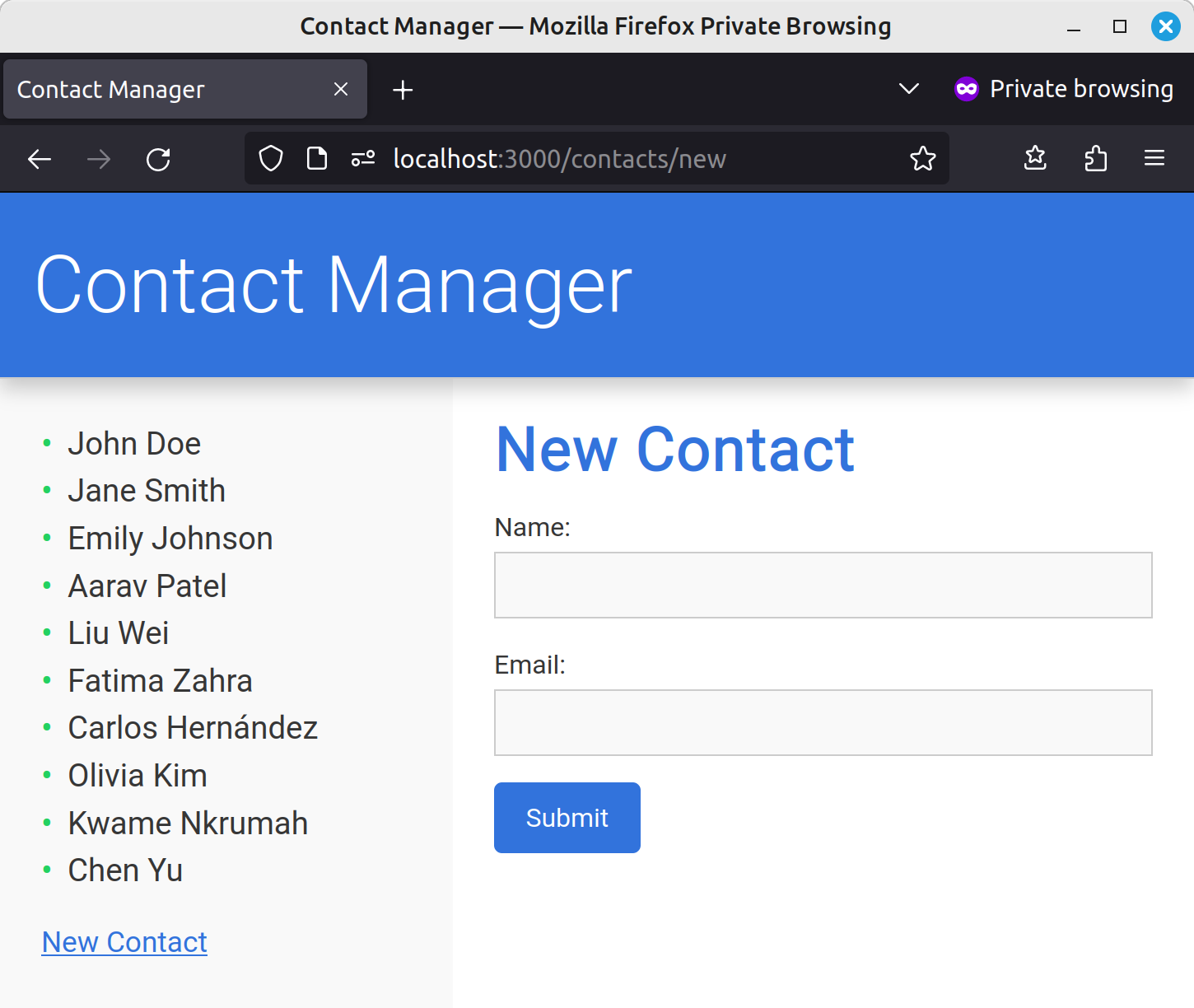
Now we have got to create a path to deal with sort submission.
First substitute app.js to provide us entry to the shape’s knowledge inside our route handler.
const categorical = require('categorical');
const path = require('path');
const routes = require('./routes/index');
const app = categorical();
app.set('views', path.be a part of(__dirname, 'views'));
app.set('view engine', 'pug');
+ app.use(categorical.urlencoded({ prolonged: true }));
app.use(categorical.static('public'));
app.use("https://www.sitepoint.com/", routes);
const server = app.pay attention(3000, () => {
console.log(`Categorical is engaged on port ${server.take care of().port}`);
});
Beforehand, we would have used the body-parser package deal deal deal, nonetheless I not too means again realized that is not obligatory.
Then add the following to index.js:
router.submit('/contacts', (req, res) => {
const newContact = {
id: contacts.measurement + 1,
title: req.physique.title,
electronic mail: req.physique.electronic mail,
};
contacts.push(newContact);
if (req.headers['hx-request']) {
res.render('sidebar', { contacts });
} else {
res.render('index', { motion: 'new', contacts, contact: {} });
}
});
Correct proper right here, we’re making a mannequin new contact with the information we acquired from the patron and along with it to the contacts array. We’re then re-rendering the sidebar, passing it the up to date itemizing of contacts.
Uncover that, everytime you’re making any sort of software program program that has shoppers, it’s as so much as you to validate the information you’re receiving from the patron. In our event, I’ve added some elementary client-side validation, nonetheless this will likely sometimes merely be bypassed.
There’s an event of the easiest way to validate enter on the server utilizing the express-validator package deal deal deal package deal deal deal contained in the Node tutorial I linked to above.
Now, everytime you refresh your browser and take a look at along with a contact, it ought to work as anticipated: the mannequin new contact have to be added to the sidebar and the shape have to be reset.
Along with flash messages
That is efficiently and good, nonetheless now we want a chance to inform the patron {{{that a}}} contact has been added. In a typical software program program, we would use a flash message — a short lived notification that alerts the patron concerning the end outcomes of an motion.
The issue we encounter with htmx is that we’re updating the sidebar after successfully making a mannequin new contact, nonetheless this isn’t the place we wish our flash message to be displayed. A bigger location could be above the mannequin new contact sort.
To get spherical this, we’re going to use the hx-swap-oob attribute. This lets you specify that some content material materials supplies in a response have to be swapped into the DOM someplace apart from the aim, that’s “Out of Band”.
Change the route handler as follows:
if (req.headers['hx-request']) {
res.render('sidebar', { contacts }, (err, sidebarHtml) => {
const html = `
Contact was successfully added!
${sidebarHtml}
`;
res.ship(html);
});
} else {
res.render('index', { motion: 'new', contacts, contact: {} });
}
Correct proper right here, we’re rendering the sidebar as prior to, nonetheless passing the render methodology an nameless operate on account of the third parameter. This operate receives the HTML generated by calling res.render('sidebar', { contacts }), which we’re going to then use to assemble our remaining response.
By specifying a swap technique of "afterbegin", the flash message is inserted on the prime of the container.
Now, as quickly as we add a contact, we should always at all times always get a pleasant message informing us what occurred.
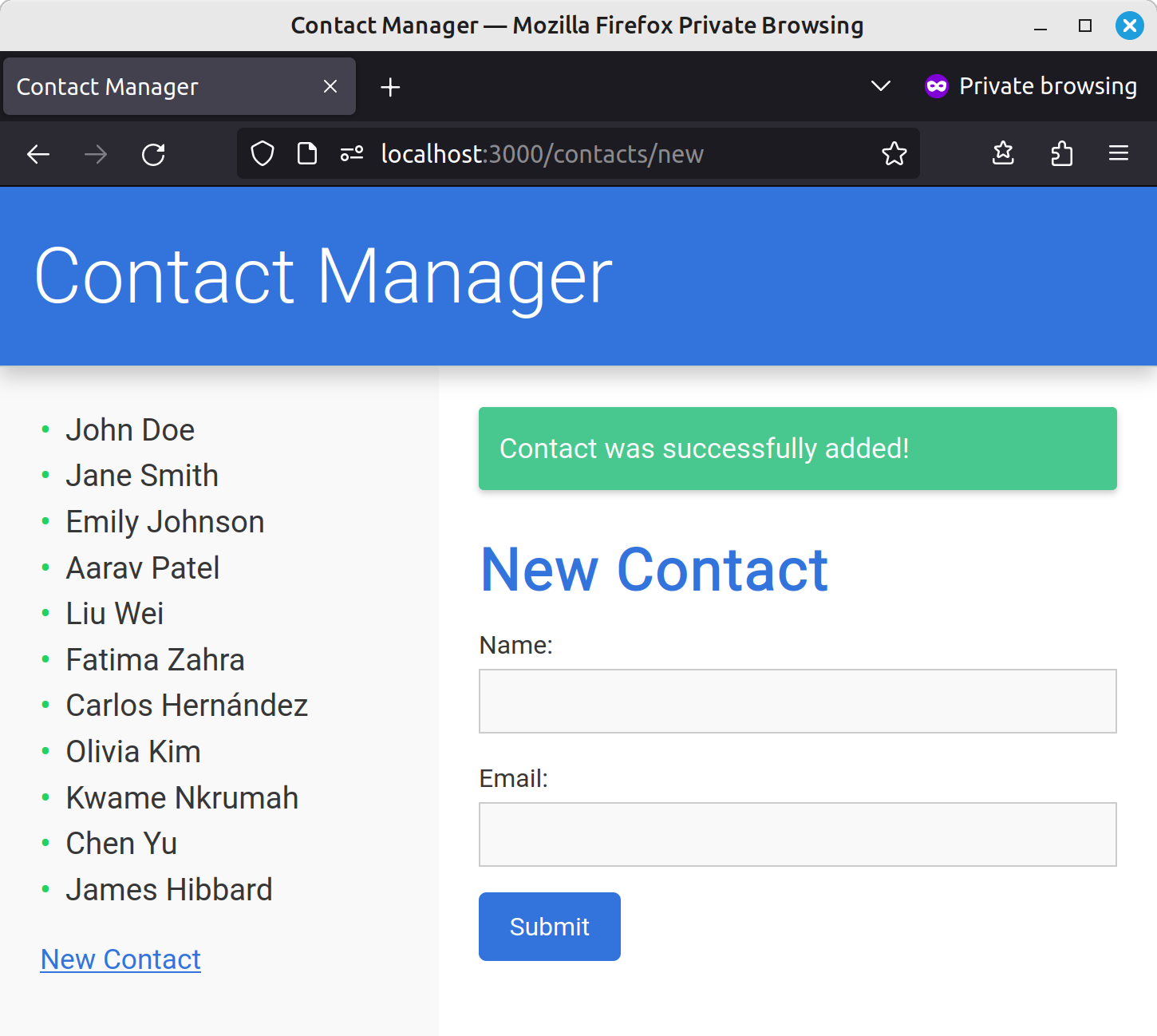
For updating a contact, we’re going to reuse the shape we created inside the sooner half.
Let’s begin by updating our contact.pug template so as in order so as to add the following:
div.actions
a(
href=`/contacts/${contact.id}/edit`,
hx-get=`/contacts/${contact.id}/edit`,
hx-target='#content material materials supplies',
hx-push-url='true'
) Edit Contact
It’ll add an Edit Contact button beneath a contacts particulars. As we’ve seen prior to, when the hyperlink is clicked, hx-get will make a GET request through Ajax to the /${contact.id}/edit endpoint, hx-target will specify the place to insert the response, and hx-push-url will be certain that the URL is modified.
Now let’s alter our index.pug template to make the most of the shape:
when 'edit'
embrace sort.pug
Furthermore add a route handler to level out the shape:
router.get('/contacts/:id/edit', (req, res) => {
const { id } = req.params;
const contact = contacts.uncover((c) => c.id === Quantity(id));
if (req.headers['hx-request']) {
res.render('sort', { contact });
} else {
res.render('index', { motion: 'edit', contacts, contact });
}
});
Uncover that we’re retrieving the contact utilizing the ID from the request, then passing that contact to the shape.
We’ll furthermore ought to substitute our new contact handler to do the an an identical, nonetheless correct proper right here passing an empty object:
// GET /contacts/new
router.get('/contacts/new', (req, res) => {
if (req.headers['hx-request']) {
- res.render('sort');
+ res.render('sort', { contact: {} });
} else {
res.render('index', { motion: 'new', contacts, contact: {} });
}
});
Then we have got to interchange the shape itself:
- isEditing = () => !(Object.keys(contact).measurement === 0);
h2=isEditing() ? "Edit Contact" : "New Contact"
sort(
motion=isEditing() ? `/substitute/${contact.id}?_method=PUT` : '/contacts',
methodology='POST',
hx-post=isEditing() ? false : '/contacts',
hx-put=isEditing() ? `/substitute/${contact.id}` : false,
hx-target='#sidebar',
hx-push-url=isEditing() ? `/contacts/${contact.id}` : false
hx-on::after-request='if(occasion.part.worthwhile) this.reset()',
)
label(for='title') Decide:
enter#title(sort='textual content material materials', title='title', required, worth=contact.title)
label(for='electronic mail') E-mail:
enter#electronic mail(sort='electronic mail', title='electronic mail', required, worth=contact.electronic mail)
div.actions
button(sort='submit') Submit
As we’re passing in every a contact or an empty object to this fashion, we now have a straightforward option to resolve if we’re in “edit” or “create” mode. We’re able to do that by checking Object.keys(contact).measurement. We’re able to furthermore extract this verify right into a little bit of bit helper operate on the prime of the file utilizing Pug’s unbuffered code syntax.
As rapidly as everybody is aware of which mode we uncover ourselves in, we’re going to conditionally change the net internet web page title, then determine which attributes we add to the shape tag. For the edit sort, we have got in order so as to add a hx-put attribute and set it to /substitute/${contact.id}. We furthermore ought to substitute the URL as rapidly as a result of the contact’s particulars have been saved.
To do all of this, we’re going to revenue from the truth that, if a conditional returns false, Pug will omit the attribute from the tag.
That suggests that this:
sort(
motion=isEditing() ? `/substitute/${contact.id}?_method=PUT` : '/contacts',
methodology='POST',
hx-post=isEditing() ? false : '/contacts',
hx-put=isEditing() ? `/substitute/${contact.id}` : false,
hx-target='#sidebar',
hx-on::after-request='if(occasion.part.worthwhile) this.reset()',
hx-push-url=isEditing() ? `/contacts/${contact.id}` : false
)
… will compile to the following when isEditing() returns false:
sort
motion="/contacts"
methodology="POST"
hx-post="/contacts"
hx-target="#sidebar"
hx-on::after-request="if(occasion.part.worthwhile) this.reset()"
>
...
sort>
Nonetheless when isEditing() returns true, it must compile to:
sort
motion="/substitute/1?_method=PUT"
methodology="POST"
hx-put="/substitute/1"
hx-target="#sidebar"
hx-on::after-request="if(occasion.part.worthwhile) this.reset()"
hx-push-url="/contacts/1"
>
...
sort>
In its substitute state, uncover that the shape motion is "/substitute/1?_method=PUT". This question string parameter has been added on account of we’re utilizing the method-override package deal deal deal, and it’ll make our router reply to a PUT request.
Out of the sphere, htmx can ship PUT and DELETE requests, nonetheless the browser can’t. Which suggests that, if we wish to preserve a state of affairs the place JavaScript is disabled, we would wish to duplicate our route handler, having it reply to each PUT (htmx) and POST (the browser). Utilizing this middleware will preserve our code DRY.
Let’s go forward and add it to app.js:
const categorical = require('categorical');
const path = require('path');
+ const methodOverride = require('method-override');
const routes = require('./routes/index');
const app = categorical();
app.set('views', path.be a part of(__dirname, 'views'));
app.set('view engine', 'pug');
+ app.use(methodOverride('_method'));
app.use(categorical.urlencoded({ prolonged: true }));
app.use(categorical.static('public'));
app.use("https://www.sitepoint.com/", routes);
const server = app.pay attention(3000, () => {
console.log(`Categorical is engaged on port ${server.take care of().port}`);
});
Lastly, let’s substitute index.js with a mannequin new route handler:
router.put('/substitute/:id', (req, res) => {
const { id } = req.params;
const newContact = {
id: Quantity(id),
title: req.physique.title,
electronic mail: req.physique.electronic mail,
};
const index = contacts.findIndex((c) => c.id === Quantity(id));
if (index !== -1) contacts[index] = newContact;
if (req.headers['hx-request']) {
res.render('sidebar', { contacts }, (err, sidebarHtml) => {
res.render('contact', { contact: contacts[index] }, (err, contactHTML) => {
const html = `
${sidebarHtml}
Contact was successfully up to date!
${contactHTML}
`;
res.ship(html);
});
});
} else {
res.redirect(`/contacts/${index + 1}`);
}
});
Hopefully there’s nothing too mysterious correct proper right here by now. Initially of the handler we seize the contact ID from the request params. We then uncover the contact we have to substitute and swap it out with a mannequin new contact created from the shape knowledge we acquired.
When coping with an htmx request, we first render the sidebar template with our up to date contacts itemizing. We then render the contact template with the up to date contact and use the outcomes of each of those calls to assemble our response. As prior to, we use an “Out of Band” substitute to create a flash message informing the patron that the contact was up to date.
At this diploma, you may have the flexibleness to interchange contacts.
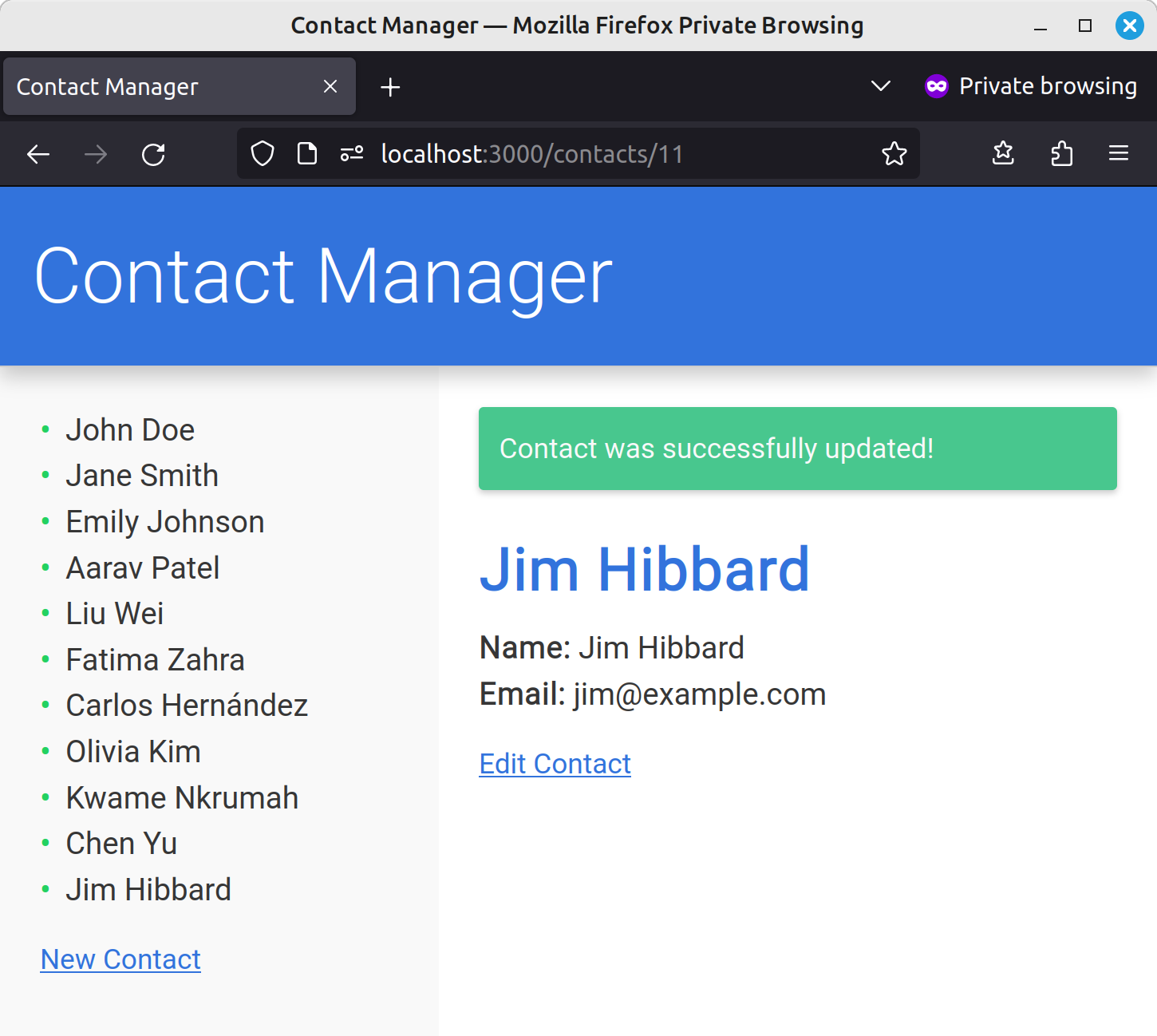
The final phrase piece of the puzzle is the pliability to delete contacts. Let’s add a button to do that to our contact template:
div.actions
sort(methodology='POST', motion=`/delete/${contact.id}?_method=DELETE`)
button(
sort='submit',
hx-delete=`/delete/${contact.id}`,
hx-target='#sidebar',
hx-push-url='/contacts'
class='hyperlink'
) Delete Contact
a(
)
Uncover that it’s good apply to make the most of a kind and a button to drawback the DELETE request. Varieties are designed for actions that set off modifications, like deletions, and this ensures semantic correctness. Moreover, utilizing a hyperlink for a delete motion might in all probability be dangerous on account of serps can inadvertently observe hyperlinks, probably resulting in undesirable deletions.
That being talked about, I’ve added some CSS to vogue the button like a hyperlink, as buttons are ugly. Inside the event you copied the sorts from the repo prior to, you have already got this in your code.
And eventually, our route handler in index.js:
router.delete('/delete/:id', (req, res) => {
const { id } = req.params;
const index = contacts.findIndex((c) => c.id === Quantity(id));
if (index !== -1) contacts.splice(index, 1);
if (req.headers['hx-request']) {
res.render('sidebar', { contacts }, (err, sidebarHtml) => {
const html = `
Contact was successfully deleted!
${sidebarHtml}
`;
res.ship(html);
});
} else {
res.redirect('/contacts');
}
});
As rapidly as a result of the contact has been eradicated, we’re updating the sidebar and displaying the patron a flash message.
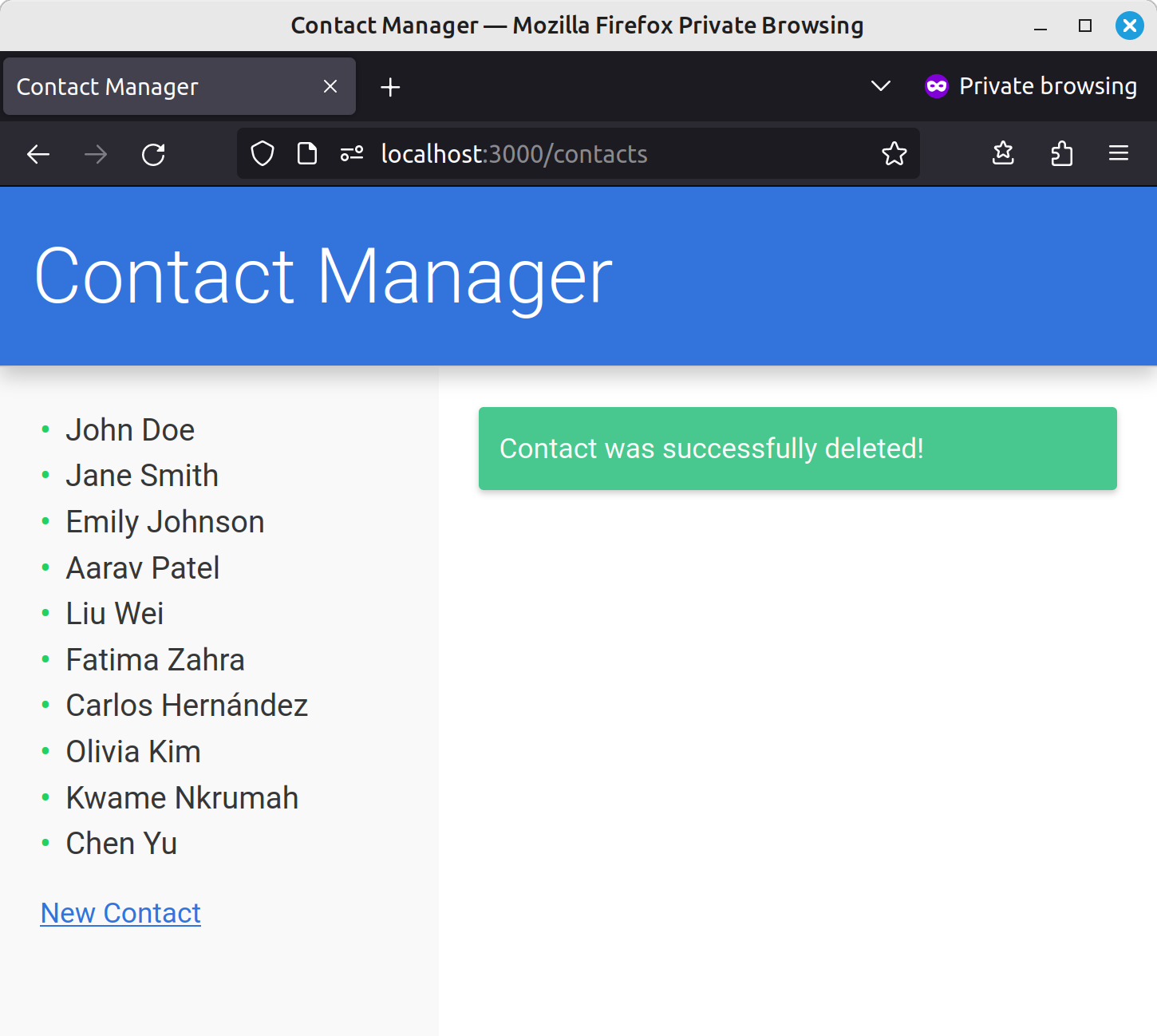
Taking It Additional
And that’s a wrap.
On this textual content, we’ve crafted a full-stack CRUD software program program utilizing Node and Categorical for the backend and htmx for the frontend. Alongside the easiest way by which, I’ve demonstrated how htmx can simplify along with dynamic conduct to your internet apps, lowering the necessity for stylish JavaScript and full-page reloads, and thus making the patron expertise smoother and additional interactive.
And as an added bonus, the app furthermore choices efficiently with out JavaScript.
Nonetheless whereas our app is fully useful, it’s admittedly a little bit of bit bare-bones. Inside the event that you must proceed exploring htmx, it is doable you will like to check out implementing view transitions between app states, or along with some additional validation to the shape — for instance, to substantiate that the e-mail take care of comes from a specific house.
I’ve examples of each of these items (and additional apart from) in my Introduction to htmx.
Aside from that, whenever you’ve any questions or strategies, please attain out on X.
Glad coding!
